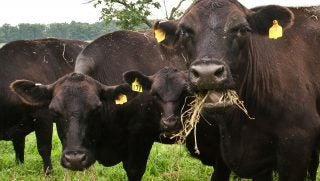Bermuda grass, Tifton 85, can be hard for cattle to digest as the summer season progresses, however Texas A&M AgriLife researchers have found adding a little dried distillers’ grains to the mix can aid with digestion and keep cattle grazing.
Left over from ethanol production, dried distillers’ grains are commonly used as a relatively cheap source of feed. In some instances, it can replace primary feed ingredients like corn or soybeans. Some supplements provide additional energy, some more protein, and others minerals. The distillers’ grain is used for both protein and energy.
“Due to the ramp-up in ethanol production over the past few decades, there has been an abundance of this byproduct in the beef industry,” explains Monte Rouquette, a professor with Texas A&M AgriLife Research. “Originally viewed as a waste product of the industry, research began looking into other uses of the byproduct.”
A common forage grass across the south and southeast United States, Tifton 85 Bermuda becomes harder for livestock to digest as it matures. The cattle have a harder time extracting nutrients from the grass. Dried distillers’ grains can help add back those nutrients.
The results of this study, conducted by W. Brandon Smith, point to a potential two-season grazing strategy, based on animal size, weight, and age. For example, lightweight animals could graze in the early summer without the grain supplement because the grass is able to give them the needed nutrients to thrive.
In the later part of the summer, the matured animals could graze with the distillers’ grain supplement. The grain would add back some of the nutrients the cattle lose out on when the grass is further into season.
This research allows the scientists to determine the most effective and efficient way to use distillers’ grains as a supplement. They can learn how much is best to give, when is best to give it, and how much return it can provide a rancher.
“These data can then be used in an economic assessment to provide a baseline of potential responses from the use of a supplement,” says Rouquette. “This work sheds light on changes that occur chemically within the plant across the year that affect its digestibility.”


